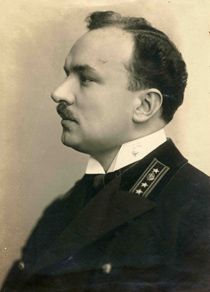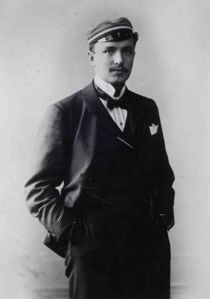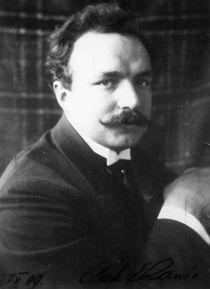

 Eižens Laube
Eižens Laube
 Eižens Laube
Eižens Laube
 Eižens Laube
Eižens Laube













In the beginning of 20th century, when Riga architecture school flourished and gained foothold, already the third generation of professional Latvian architects after J. F. Blaumanis and K. Pēkšēns started their creative work. This generation was fronted by Eižens Laube. Architecture styles and artistic trends one after another were swiftly substituted by new ones. At the beginning of the century eclectism was substituted by Art Nouveau, 20ies saw the development of functionalism and 30ies also a parallel development of neo-eclectism. E. Laube was always in the very centre of these stylistic twists and turns. He contributed immensely to the progress of event both as architect - practitioner, architect - theoretician and also teacher. In Riga alone more than 200 buildings have been built, reconstructed and renovated according to his designs, among them about 80 multi-storey stonework construction projects.
Eižens Laube was born in Riga on the 25th of May, 1880. His father Kārlis Teodors Laube (1862-1920) was a master pottery craftsman and trader. He had arrived in Riga from the north of Vidzeme region where his ancestors had been farmers and craftsmen for many generations. Already as a boy Eižens Laube got acquainted with construction work and projects – his mother's stepfather was in construction business. Thus Eižens' interest in architecture arose and in 1899, after graduating from Realschule named after Peter I, he enrolled in Riga Polytechnical Institute, architecture department. In his student days he stood out among others with his brilliant artistic talent and outstanding work capability, and reached professional maturity quite early. In 1900 alongside with his studies Eižens started working in K.Pēkšēns' construction design firm, where a study colleague of his, Aleksandrs Vanags, was also employed. In 1904 Laube went to Finland together with Vanags. There he admired buildings designed by L. Sonck, E. Saarinen, A. Lindgren, H. Gesellius and established personal contact with the Finnish architects G. Lindberg and K. Wasastjerna. Later Laube travelled even more to improve his professional skills – in 1909 he visited Sweden, Denmark and Germany and in 1910 – Germany and France.
In 1906 he graduated from the Riga Polytechnical Institute with the diploma of engineer architect. He worked for K. Pēkšēns for one more year and then in 1907 opened his own architectural design firm that soon became one of the largest in Riga. At the same time he was invited to teach at this own Alma Mater, and E. Laube became associate professor at RPI at the age of 27. He lectured on theoretical subjects as well as conducted classes in drawing and architecture design. At a time when teachers at the institute were all local Germans and education in architecture had slipped into a certain stagnation, the young Latvian associate professor brought a multitude of fresh and new things into academic work.
E. Laube worked as a teacher also elsewhere. From 1907 to 1908 he taught technical drawing and construction forms at the technical department of Public courses, established by him, J. Rozentāls and A. Vanags at the Riga Latvian Society.
Starting from the year 1909 E. Laube together with architects W. Bockslaff and K. Felsko was the official counsellor in art matters of Riga City Council building authority. He was also invited to be in the jury of several big contests, for instance, in 1910 he was the judge of projects for Ozoliņš' tenement building at 88 Brīvības Street in Riga and in 1912 participated in the jury of the international project contest for Tallinn town hall. E. Laube also participated in several contests with his own projects, and did that with remarkable success - before 1912 nine of his works were prize-winners of various project contests.
During World War I he closed down his firm and together with the Riga Polytechnical Institute evacuated to Moscow in 1915. In 1917 E. Laube returned to Riga and continued working in the field of architecture education. In University of Latvia he was in charge of one of the architecture design workshops, workshop „A”, and during certain periods of time was also the dean of the faculty and even the rector of the University. In 1920 E. Laube became a professor and in 1930 – Honorary doctor of architecture. From 1924 to 1936 he was the chairman of Commission of architectonic matters at National building committee, in 1937 he was elected corresponding member of Royal Institute of British Architects. In 1940 E. Laube was awarded the Fatherland Award, he is also the bearer of Three-Star Order, the Cross of Recognition and the Swedish Royal Order of Vasa. In 1944, just like many other Latvian intellectuals, he emigrated. At first he lived in Berlin, then in 1950 moved to the USA, worked in an architecture design office in Olympia, Washington, and since 1955 lived in Portland, Oregon, where he spent the rest of his life.
During the course of his very fruitful life E. Laube has published a great number of articles on different issues concerning the art of building, from the much-quoted essay „On the style of building” („Zalktis” – 1908. – issue No 4. – pages 145 through 148) to the impressive volume of the book „Writings on architecture” (Lincoln, Nebraska, 1960 – 205 pages). He has immensely contributed to the theory of architecture with his „Logic of colour and shape” (Riga, 1921. – 74 pages) and in his final years in Portland E. Laube wrote a manuscript of nearly 700 pages in typescript – „Manifestation of Architecture” which can now be found at the Architecture museum of Riga.
However, the most significant part of the master's heritage is his buildings. A vast majority of them were created before World War I – during a time when Riga was experiencing a building boom. The first works by Laube saw daylight in the firm of K. Pēkšēns. There is at least half a dozen of them and all are fine monuments of architecture.